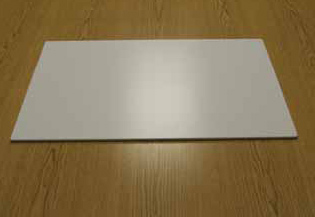It All Adds Up!
Properly measuring snow is as much of an art as it is a science…
By Chris Stachelski - Meteorologist Intern
February 6, 2016 - At first, measuring snowfall sounds simple – get a ruler, go outside, stick it in the ground and there you have it – a snowfall measurement! Not really. Unlike a lot of other meteorological phenomena that are measured or observed by high-tech equipment, proper snowfall measurements are taken with relatively simple equipment that has not changed all that much in over a century.
Snowfall is one of the few meteorological variables that is somewhat more subjective than quantitative in nature. Two people could go to the very same area, with the very equipment and get two completely different (but somewhat close) snowfall amounts. Given the subjective aspect to snowfall area and accurate snowfall measurements can help keep track of this precious commodity. Accurate snowfall measurements also provide verification for warnings and advisories, alert of potential road hazards, inform outdoor enthusiasts about how much snow has fallen and also assist in compiling climate records.
What sorts of instruments are needed to measure snowfall properly?
 The first piece of equipment necessary for measuring snow accurately is a snowboard. A snowboard is a piece of plywood or flat plastic board painted white. This board should be white in order to minimize radiation and melting effects and where observations of snowfall should be taken. Ideally, a snowboard should be about 2 feet wide by 2 feet long and about a half of an inch thick. One alternative that can be used as a snowboard is a white, plastic cutting board. However, be sure to avoid measuring in any "moat" that such a board would have. Snowboards should be cleaned off after each observation of snowfall is taken and set flush with the existing snow surface. Next, you'll need a measuring tool. A ruler or yardstick is the most critical tool as without one, there's no way to measure snow at all. A metal ruler or yardstick is best as you can push it into the snow easier. If you live in an area that gets snowfall totals over a foot frequently, a yardstick is a better way to go. Look for a ruler or yardstick that is thicker; a thin one will be rather flimsy and may bend when you try to insert it into the ground. At some official cooperative weather stations, observers will be equipped with a snowstick, essentially just a ruler used to measure snow with the above features in mind.
The first piece of equipment necessary for measuring snow accurately is a snowboard. A snowboard is a piece of plywood or flat plastic board painted white. This board should be white in order to minimize radiation and melting effects and where observations of snowfall should be taken. Ideally, a snowboard should be about 2 feet wide by 2 feet long and about a half of an inch thick. One alternative that can be used as a snowboard is a white, plastic cutting board. However, be sure to avoid measuring in any "moat" that such a board would have. Snowboards should be cleaned off after each observation of snowfall is taken and set flush with the existing snow surface. Next, you'll need a measuring tool. A ruler or yardstick is the most critical tool as without one, there's no way to measure snow at all. A metal ruler or yardstick is best as you can push it into the snow easier. If you live in an area that gets snowfall totals over a foot frequently, a yardstick is a better way to go. Look for a ruler or yardstick that is thicker; a thin one will be rather flimsy and may bend when you try to insert it into the ground. At some official cooperative weather stations, observers will be equipped with a snowstick, essentially just a ruler used to measure snow with the above features in mind.How do you measure snow?
Once you have the necessary equipment, and snow to measure, it's time to take your measurements, there are some general 'best practice' guidelines that can help you to take a more accurate snowfall measurement.
Your measurements should be taken on a snowboard. If you don't have a snowboard, use a wooden deck or grassy surface, however air pockets lurk in the grass and this can cause a slight over-measurement of snow. Do not measure snow on a paved surface, sidewalk or gravel surface as these are sources of heat and will cause snow to be under-measured. Snow should be measured in an area as far away from obstructions such as buildings, trees and fences, at least a minimum of 20 feet. These obstructions can cause funneling of wind or create localized wind patterns that cause blowing and drifting of snow. In addition, gusty winds can often blow snow off the roof of a building or tree tops and land it on the ground thus inflating how much snow fell. Be alert for recording snow in areas that are shaded versus in direct sunlight. Shaded areas will see higher totals. In this case, it may be best to average a total of the two if sunlight was an issue before you had a chance to measure snow. Watch for areas where snow has drifted. In events where drifting took place, snowfall should be measured in an area that looks to be a level average between the highest and lowest drifts. Areas where human or animal activity has disturbed snowpack are also not ideal spots to measure snow accurately. Also, never take just one measurement. Several measurements should be taken in your desired area and then averaged together to get your snowfall total.
Why are precise snowfall measurements important?
Accurate measurements of weather variables are always important, no matter what weather parameter is being reported. Despite an increasingly automated weather observing network, accurate ground measurements of snowfall confirm values from automated sensors such as the SNOTEL network and remotely sensed satellite images. Snowfall is also the primary source of water in this measurement. It is important to remember when you report snowfall, that you only want to measure the amount of new snow that has fallen on the ground. This can be since a set time once a day or since the start time of an event. Since snow compacts with time, taking frequent measurements during an event will result in an over-measurement. At best take a measurement once every six hours. If you measure all the snow on the ground, including old snow, this NOT snowfall but rather snow depth.
Source: NOAA









